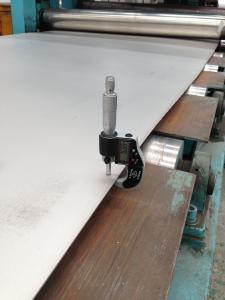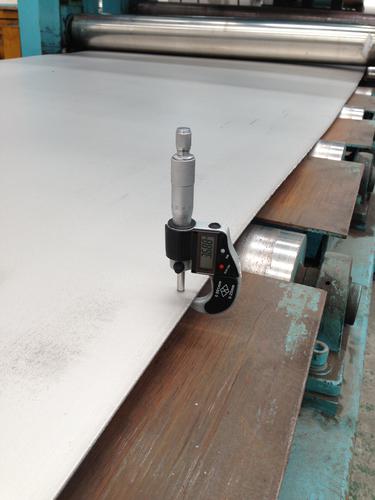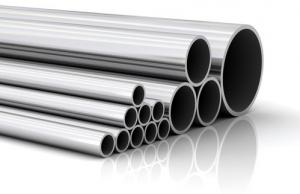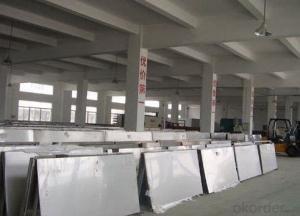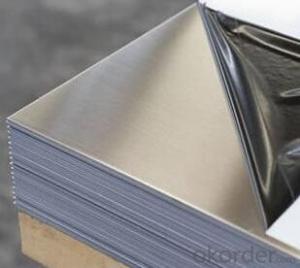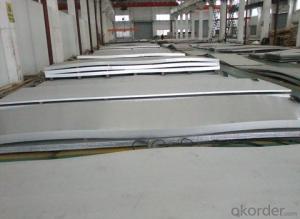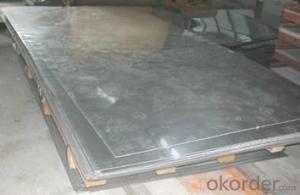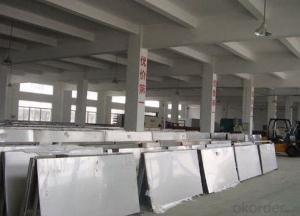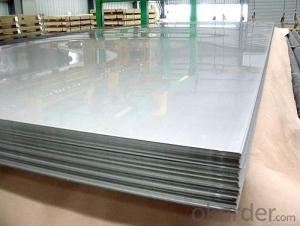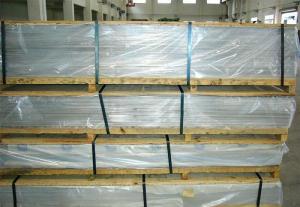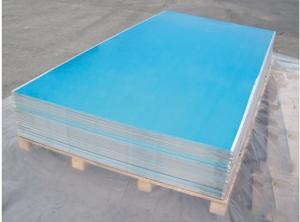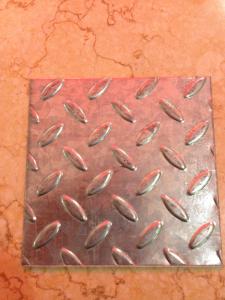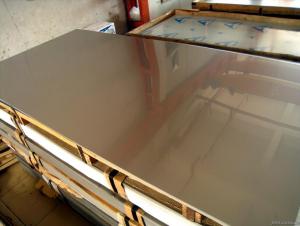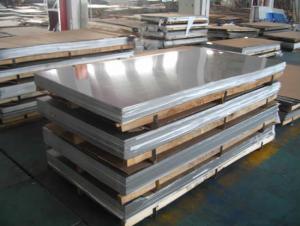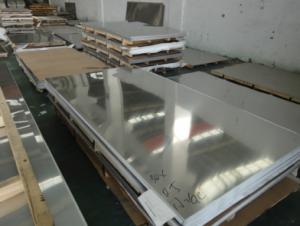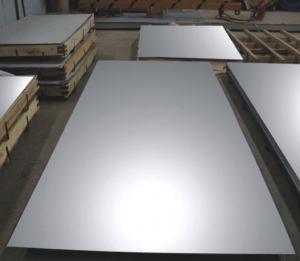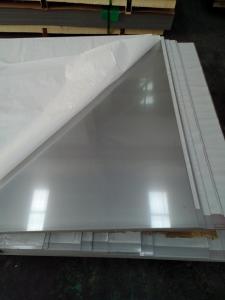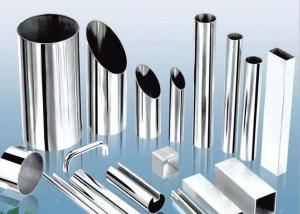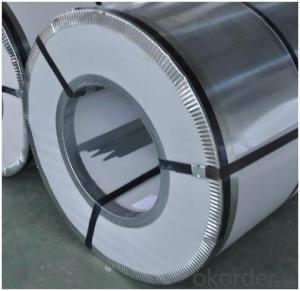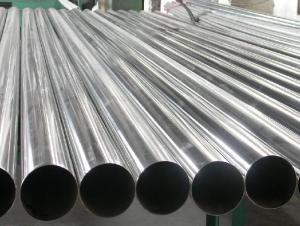Stainless Steel Sheet With Best Price In Warehouse Stocks
- Loading Port:
- Shanghai
- Payment Terms:
- TT or LC
- Min Order Qty:
- 6 m.t.
- Supply Capability:
- 5000 m.t./month
OKorder Service Pledge
OKorder Financial Service
You Might Also Like
1.Structure of Product Description
Stainless steel sheet , stainless steel plate, stainless steel slabs are all widely used in the field of construction field and decoration field, etc. There are many different grades, such as: 200 series, 300 series, 400 series, 900series, etc. The detailed grade are as follows: 201, 202, 301, 304, 316, 410, 420, 430, etc.
The surface is including 2B, BA, Mirror Finish, Checkered, etc.
if you have the detailed inquiry, please feel free to show us your inquiry, so that i can quote you price later. thanks in advance.
2. Main features of the product
a. Competitive price
b. Frist-Class Service.
c. Shortest service.
3. Image.
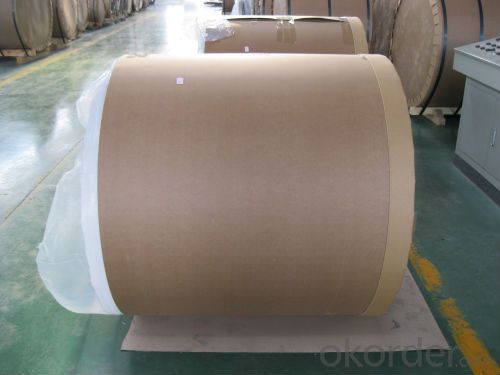
4. Product detailed sizes:
1000mm*2000mm, 1219mm*2438mm,1500mm*3000mm, etc.
5. FAQ:
What is the quality standard?
---Usually our standard is GB3880-2006 or else.
What is the width range?
---It is from 1000mm to 2500mm, etc.
What is the length range?
---It is from 2000mm to 6000mm, etc.
Where is your client from?
---Normally it is from Japan, USA, ENGLISH, SINGAPORE,FIJI, AUSTRALIA,CANADA, UAE, SAUDI ARABIA, ETC.
What is your mainly products?
---Normally they are stainless steel sheet, stainless steel coil, stainless steel checkered sheet, stainless steel mirror finished sheet, color coated stainless steel sheet, etc.
- Q: What is the minimum order quantity for stainless steel sheets?
- The minimum order quantity for stainless steel sheets can vary depending on the supplier and the specific product. However, it is common for suppliers to have a minimum order quantity ranging from 1 to 10 sheets. It is important to contact different suppliers and inquire about their minimum order requirements to find the best option that suits your needs.
- Q: What are the pricing options for stainless steel sheets?
- The pricing options for stainless steel sheets can vary depending on factors such as the size, thickness, grade, and finish of the sheets. Generally, stainless steel sheets can range in price from around $30 to $300 per sheet.
- Q: Can stainless steel sheets be used for elevator floors?
- Yes, stainless steel sheets can be used for elevator floors. Stainless steel is a durable and hygienic material that is resistant to corrosion and staining, making it a suitable choice for elevator flooring.
- Q: Can stainless steel sheets be used for mezzanine flooring?
- Indeed, mezzanine flooring can be constructed using stainless steel sheets. Being a robust and corrosion-resistant substance, stainless steel proves itself appropriate for diverse purposes, such as flooring. With its exceptional durability and ability to endure substantial weights, stainless steel emerges as an optimal choice for mezzanine structures. Moreover, the advantage of hassle-free cleaning and maintenance guarantees a sanitary and visually appealing flooring alternative.
- Q: Are stainless steel sheets resistant to galvanic corrosion?
- Yes, stainless steel sheets are resistant to galvanic corrosion. Galvanic corrosion occurs when two dissimilar metals come into contact in the presence of an electrolyte, such as moisture or saltwater. In such cases, one metal acts as an anode and the other as a cathode, leading to the transfer of electrons and the corrosion of the anode. Stainless steel is an alloy that contains chromium, which forms a passive oxide layer on its surface. This oxide layer acts as a protective barrier, preventing the transfer of electrons and thus effectively resisting galvanic corrosion. The chromium in stainless steel reacts with oxygen in the air to create a thin, invisible, and self-repairing layer of chromium oxide. This layer provides excellent corrosion resistance and makes stainless steel highly resistant to galvanic corrosion when in contact with other metals. However, it is important to note that the level of corrosion resistance may vary depending on the specific grade and composition of stainless steel used. Some stainless steel alloys, such as Type 316 stainless steel, offer even higher resistance to galvanic corrosion due to the addition of molybdenum, which enhances its corrosion resistance in aggressive environments. In summary, stainless steel sheets are generally highly resistant to galvanic corrosion due to the presence of a passive chromium oxide layer on their surface. This makes stainless steel a reliable choice for applications where galvanic corrosion is a concern, such as in marine environments or when in contact with dissimilar metals.
- Q: What is the cost of stainless steel sheets?
- The price of stainless steel sheets may differ based on various factors including the thickness, size, and grade of stainless steel employed. Typically, stainless steel sheets are priced per square foot or square meter. The price range can further be influenced by the supplier, location, and market conditions. Moreover, any additional processing or finishing requirements like polishing or cutting can impact the overall cost. To obtain precise and current pricing details for stainless steel sheets, it is advisable to reach out to a local supplier or distributor.
- Q: Can stainless steel sheets be used for heat exchangers?
- Yes, stainless steel sheets can be used for heat exchangers. Stainless steel is a popular material choice for heat exchangers due to its high corrosion resistance, durability, and excellent heat transfer properties. It can withstand high temperatures and is resistant to both chemical and physical damage, making it suitable for various industrial applications. Additionally, stainless steel sheets can be easily fabricated into different shapes and sizes, allowing for customization to meet specific heat exchanger requirements.
- Q: Can stainless steel sheets be used in the aerospace industry?
- Yes, stainless steel sheets can be used in the aerospace industry. Stainless steel possesses excellent strength, corrosion resistance, and high-temperature stability, making it suitable for various aerospace applications such as aircraft frames, engine components, and structural parts.
- Q: What is the minimum thickness of stainless steel sheets available?
- The minimum thickness of stainless steel sheets offered may differ based on the manufacturer and the particular grade of stainless steel employed. Typically, the thinnest stainless steel sheets offered range from 0.4mm to 0.5mm. Nevertheless, it is worth mentioning that certain manufacturers might provide thinner sheets, like 0.3mm, although these may be more specialized or not as readily accessible. If you have a specific thickness requirement for your project, it is advisable to seek guidance from stainless steel suppliers or manufacturers to ascertain the available choices.
- Q: What are the different types of edge profiles for stainless steel sheets?
- Some different types of edge profiles for stainless steel sheets include square edge, round edge, beveled edge, and chamfered edge.
Send your message to us
Stainless Steel Sheet With Best Price In Warehouse Stocks
- Loading Port:
- Shanghai
- Payment Terms:
- TT or LC
- Min Order Qty:
- 6 m.t.
- Supply Capability:
- 5000 m.t./month
OKorder Service Pledge
OKorder Financial Service
Similar products
Hot products
Hot Searches
Related keywords
